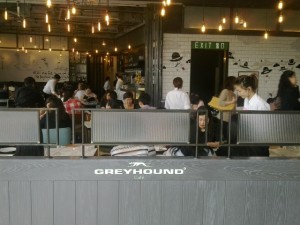Can the Gaia Group who brought a restaurant chain first in Thailand (in 1997, as a line extension of its fashion label which it started in 1980 with men’s casual wear at Siam Center, followed by an expansion into women’s wear in 1990) the first Greyhound Café and now in Hong Kong with the name Greyhound Café, and use the mirror image of the iconic Greyhound Lines trademark, North America’s largest intercity bus company? Yes, they can. They did. But is it allowed? The restaurant chain’s concept is: “Life is a journey, full of pictures, places, stories, and good tasting recipes.” One asks oneself why the restaurants in IFC in Central and Ocean Terminal in Tsimshatsui cannot make their own journeys, make their own pictures, travel to their own places, come up with their own stories and recipes?
Dog that runs to the right (Greyhound Lines), dog that runs to the left (Greyhound Café)
Frank Schechter already warned in 1927 for the danger of “the gradual whittling away or dispersion of the identity and hold upon the public mind of the mark or name by its use upon non-competing goods (in this case one should also read services).” This is what we now call trademark dilution by blurring or tarnishment. In the case of the restaurant chain we deal with dilution by blurring. Likelihood of confusion is seen as one of the main functions of a trademark, because it is short-circuiting the search process. But blurring, for example when a bus company, a restaurant chain, hotels, a fashion line, makes the search process more difficult, if you do not automatically associate the name Greyhound with the bus company. Trademark dilution is not only disadvantageous for members of the public but also for the bus company, since they cannot extend their brand if their trademark or name is used for non-competing goods or services (just as Greyhound Café did from first men’s casual clothing to women’s wear to “fashion restaurants”.
What can Greyhound Lines do when a company is free-riding on its reputation it established over many years?
Even if a company does not have registered its name or logo, Hong Kong has the Common Law Action of passing off. But because Greyhound Lines is a well-known mark, because it is well-known in Hong Kong (below an overview will be given of a non-exhaustive list of factors that the Registrar and court should make reference to) and irrespective of whether the bus company carries on business in the Special Administrative Region (it does not), the Greyhound name and logo are also protected via Chapter 559, Section 12 Trade Marks Ordinance of Hong Kong (2003), which is about the Relative grounds for refusal of registration:
Section 12 (4)(b):
(i) his mark is well known;
and (ii) use of the later trade mark without due cause would take unfair advantage, or be detrimental to, the distinctive character or repute of the earlier trade mark (“the Opponent’s mark”).
Schedule 2 attached to the Trade Marks Ordinance. Non-exhaustive list of factors:
(a) the degree of knowledge or recognition of the trade mark in the relevant sectors of the public;
(b) the duration, extent and geographical area of any use of the trade mark;
(c) the duration, extent and geographical area of any promotion of the trade mark, including advertising or publicity and the presentation, at fairs or exhibitions, of the goods or services to which the trade mark applies;
(d) the duration and geographical area of any registrations, or any applications for registration, of the trade mark, to the extent that they reflect use or recognition of the trade mark;
(e) the record of successful enforcement of rights in the trade mark, in particular, the extent to which the trade mark has been recognized as a well-known trade mark by competent authorities in foreign jurisdictions;
and (f) the value associated with the trade mark.
Section 2 of the Schedule states that none of the following factors may be necessary for the purpose of determining a well known mark in Hong Kong:
(a) the trade mark has been used, or has been registered, in Hong Kong;
(b) that an application for registration of the trade mark has been filed in Hong Kong;
(c) that the trade mark is well known, or has been registered, in a jurisdiction other than Hong Kong;
(d) that an application for registration of the trade mark has been filed in a jurisdiction other than Hong Kong;
or (e) that the trade mark is well-known by the public at large in Hong Kong.

